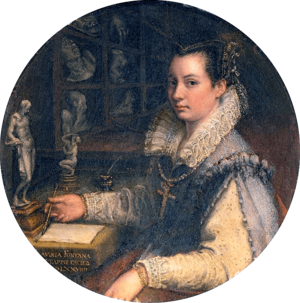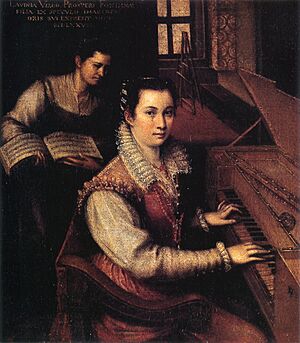Lavinia Fontana facts for kids
Quick facts for kids
Lavinia Fontana
|
|
|---|---|

Self-Portrait in the Studio, 1579
|
|
| Born | August 24, 1552 Bologna
|
| Died | August 11, 1614 Rome
|
| Resting place | Santa Maria sopra Minerva, Rome |
| Education | Prospero Fontana, Ludovico Carracci |
| Alma mater | University of Bologna |
| Style | Mannerist |
| Elected | Accademia di San Luca |
| Patron(s) | Pope Gregory XIII, Pope Clement VII, Pope Paul V |
Lavinia Fontana (born August 24, 1552 – died August 11, 1614) was a famous Italian painter. She lived and worked in the cities of Bologna and Rome. She is best known for her amazing portraits. She also painted scenes from mythology and religious art.
Lavinia learned to paint from her father, Prospero Fontana. He was a teacher at the School of Bologna. She is thought to be the first female artist in Western Europe who earned her living entirely from painting. Her family depended on her art career. Her husband even helped her by managing her work and raising their 11 children.
Contents
Her Early Life and Career
Lavinia Fontana was born in Bologna in 1552. Her father, Prospero Fontana, was a well-known painter. He taught Lavinia how to paint. Being the daughter of a painter helped her become an artist. At that time, it was not common for women to be artists.
Lavinia's first known painting was Child of the Monkey in 1575. It is now lost. Another early work, Christ with the Symbols of the Passion, from 1576, is in the El Paso Museum of Art. People in Bologna supported Lavinia's art career. This gave her chances and connections that other women artists might not have had.
She started her career by painting small religious pictures on copper. These were popular gifts for important people. In the 1580s, she became famous for painting portraits of noblewomen in Bologna. Many rich women wanted her to paint them. She earned a lot of money during this time. Lavinia often became good friends with her female clients. Some even became godmothers to her children.
Lavinia married Gian Paolo Zappi in June 1577. They lived in her father's house in Bologna. Lavinia continued to paint professionally. She even added Zappi to her signature. She had 11 children, but only three lived longer than she did. Her husband, Gian Paolo, took care of their home. He also helped Lavinia with her paintings, sometimes adding small details like clothes. Lavinia even took classes at the University of Bologna. In 1580, she was listed as one of the city's "Donne addottrinate" (women with doctorates).
Moving to Rome
Lavinia and her family moved to Rome in 1604. Pope Clement VIII invited her to come. She gained the support of the Buoncompagni family, which included Pope Gregory XIII. Later, she became the official portrait painter for the Vatican.
Lavinia was very successful in Rome, just as she had been in Bologna. Even Pope Paul V had his portrait painted by her. She received many honors. In 1611, a bronze medal was made with her portrait on it. This medal was designed by the sculptor Felice Antonio Casoni.
She was chosen to be a member of the Accademia di San Luca in Rome. This was a very important art academy. Lavinia Fontana died in Rome on August 11, 1614. She was buried at Santa Maria sopra Minerva.
Her Lasting Impact
Her painting Self-Portrait at the Clavichord with a Servant is considered her best work. She painted it as a gift for the Zappi family before her marriage. She signed it saying she was a virgin and that she painted it by looking in a mirror. This showed how accurate the portrait was.
More than 100 of her works are known, but only 32 are signed and dated today. About 25 more paintings are believed to be hers. This means she has the largest collection of works by any female artist before the 1700s. Some of her portraits were once thought to be by another artist, Guido Reni.
Lavinia also painted scenes with Roman gods like Minerva, Mars, and Venus. These paintings sometimes showed the gods without clothes. She might have been the first female artist to paint such mythological scenes.
Lavinia herself was painted by the famous artist Paolo Veronese in his Portrait of a Woman (1595). She was also the only woman artist mentioned in Giulio Mancini's book Considerations on Painting. People praised how realistic her paintings looked. The beauty of her art was even linked to her own looks.
Lavinia Fontana influenced other artists like Alberto de' Rossi and Alessandro Tiarini. She was a very successful artist who got many commissions. She earned a lot of money from her art. She is a rare example of a woman who achieved such high success in art during the Renaissance period. Her careful attention to detail showed how wealthy the people she painted were, which made her very popular among the rich.
Her Artistic Style
Who Influenced Her?
When Lavinia was young, her painting style was similar to her father's. Later, she studied with Ludovico Carracci. She slowly started to use the "Carracciesque" style, which used strong, rich colors like those seen in Venetian art.
Other female artists like Sofonisba Anguissola, Caterina Vigri, and Properzia de' Rossi may have also influenced Lavinia's career.
The Counter-Reformation was a time when the Catholic Church made new rules for religious art. These rules affected how Fontana painted her subjects and themes. To have a successful career, it was important for her to be seen as a good daughter, wife, and mother. The Church also emphasized family values, which led to more demand for portraits of families and children.
How She Painted
You can see the influence of Mannerism in Fontana's paintings. This style focuses on lots of detail and the importance of the objects around the person being painted. In her self-portraits, Fontana showed herself as both a respected lady and a professional artist. This way of showing two roles at once was common for female artists in the 1500s.
Famous Paintings
- Mystic marriage of St Catherine, c. 1575 – National Gallery of Victoria, Melbourne
- Self-Portrait with the Spinet Accompanied by a Handmaiden, 1577 – Accademia Nazionale di San Luca, Rome
- Self-Portrait with Palette and Brushes, 1579
- Portrait of a Noblewoman, c. 1580 – National Museum of Women in the Arts, Washington, D.C.
- Portrait of a Couple, 1580–1585 – Cleveland Museum of Art, Cleveland
- The Dead Christ with Symbols, 1581 – Cornell Fine Arts Museum, Winter Park, Florida
- Newborn Baby in a Crib c. 1583 - Pinacoteca Nazionale di Bologna
- Portrait of the Gozzadini Family, 1584 – Pinacoteca Nazionale di Bologna
- Portrait of Gerolamo Mercuriale, c. 1587–1590 – Walters Art Museum, Baltimore
- Holy Family, 1589 – El Escorial, Outside Madrid
- Portrait of a Lady with Lap Dog, c. 1595 – Walters Art Museum, Baltimore
- Portrait of Constanza Alidosi, c. 1595 - National Museum of Women in the Arts, Washington, D.C.
- The Visit of the Queen of Sheba to King Solomon, 1599, – National Gallery of Ireland, Dublin
- Birth of Virgin – Santissima Trinità, Bologna
- Consecration to the Virgin – Musee des Beaux-Arts, Marseilles, originally the Gnetti Chapel, Santa Maria dei Servi, Bologna
- Jesus among the Doctors – Part of the Mysteries of the Rosary in the Rosary chapel in the Basilica of San Domenico, Bologna
- Minerva Dressing, 1613 – Galleria Borghese, Rome
- Mars and Venus, c. 1600-1610 – Fundación Casa de Alba, Madrid
Images for kids
-
Portrait of a lady with a dog, 1590s, Auckland Art Gallery
-
Lavinia Fontana, cast medal, front side, designed by Felice Antonio Casone (1611), British Museum, London
See also
 In Spanish: Lavinia Fontana para niños
In Spanish: Lavinia Fontana para niños
- Women Artists
- Invisible Women: Forgotten Artists of Florence
- Sofonisba Anguissola
- List of Italian women artists
- Italian Renaissance painting









